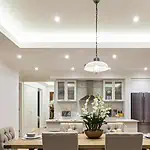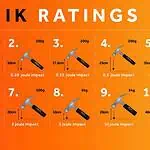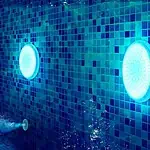Be it home or workplace, every space needs adequate lighting to provide utility. And to achieve optimal lighting, several factors have to be kept in the account. These include luminosity, colour temperature, and the interior of the spaces. Besides these, there is another essential factor that you must consider. That is beam angle, and it is the measure of how light spreads from its source. It is one of the easiest metrics to optimize the lighting in different spaces. But one must understand it comprehensively to make a decision based on it.
So, in this guide, we will discuss everything there is to know about Beam Angle. It will help optimize the lighting in your homes and offices. So, let’s get straight to it.
What Exactly Is Beam Angle?
Light is made up of tiny particles known as “photons,” when these photons are emitted, they have a certain trajectory. The angle that this trajectory makes is called the “Beam Angle.” The mechanism by which photons are produced varies in different light sources. Hence, the beam angle of the different lights also varies.
The beam angles are divided into several categories. They range from very narrow to very wide. Lights with broader beam angles spread wide. In contrast, the narrower beams have a lesser spread. Furthermore, the beam angle also impacts light intensity because it depends on the overall spread. A light that spreads more will be less intensive than that that has a narrower spread.
The light required to light up a space depends on its area and the preferred light source. It is expressed in the lumen and describes the intensity of the light. The point is a larger size would require more lumens than a narrower one. Hence, the light source should have a beam angle that spreads narrowly to brighten the entire space.
The following tables tell the light spread based on its beam angle based on NEMA. National Electrical Manufacturer Association, or NEMA, is one of the most credible associations of electrical equipment manufacturing companies. And the classification of beam angle by NEMA is widely used in the industry.
| Beam Angle | Description | NEMA Type |
| 130+ | 7 | Very Wide |
| 100-130 | 6 | Wide |
| 70-100 | 5 | Medium Wide |
| 46-70 | 4 | Medium |
| 29-46 | 3 | Medium Narrow |
| 18-29 | 2 | Narrow |
| 10-18 | 1 | Very Narrow |
Most reputed light manufacturers provide information on the beam angle of their products. You can check for it and compare it with the provided table to know the kind of spread it will have.
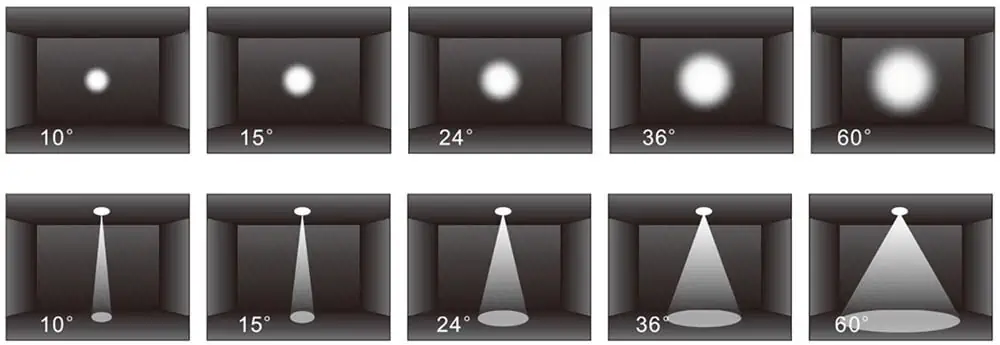
How Does Beam Angle Affect Lighting Conditions?
Beam angle affects the lighting conditions of space by impacting the spread of the light. For instance, two LED lights produce 600 lumens but have different beam spreads. The one with a broader beam angle would brighten up more area than the narrower one.
However, while the wider beam angle would provide more spread, the light would not have a high intensity. It is because photons spread over a larger area, dividing the intensity in a large area. In contrast, the narrower beam angle would not produce as much spread, but it will be more intense. Again, a narrower beam would concentrate the photons in a more limited region.
Different spaces in homes and offices have varying lighting requirements. For example, some areas require intense light to enhance the utility, while others need a better spread. Therefore, you should select a beam angle based on the utility and the lighting requirement of a particular space.
Role of Beam Angle in Different Types of Lighting
Each area has different lighting requirements, divided into three main categories. These include basic lighting, accent lighting, and decorative lighting.
Basic Lighting
Basic lighting is the most common and widely used in all spaces. You often see such lighting in living rooms, bedrooms, garages, and bathrooms. It strikes a balance between intensity and spread. Typically, the basic lighting covers the entire space with enough intensity to provide decent utility. The beam angle for such lights ranges from 120 to 90 degrees, depending on the size of the area.
Accent Lighting
Accent lighting highlight a particular area in a space. For example, you can use it to brighten up the living room’s seating area or highlight the walls’ colour. Because it does not require a wider spread, you can use light with narrower beam angles. Lights with such a beam angle light up only a selected area and provide profound intensity. Typically, you use Medium Narrow or Narrow beam angles for accent lighting.
Decorative Lighting
Decorative lighting, as the name suggests, is used for decoration. For example, you can use them to highlight a decoration piece or install different coloured lights in some parts of the homes. Typically, narrow and very narrow light beams are used for this purpose. These lights do not have to brighten up a large space but a narrow region. And the narrower angles provide exactly that while offering more intensity.
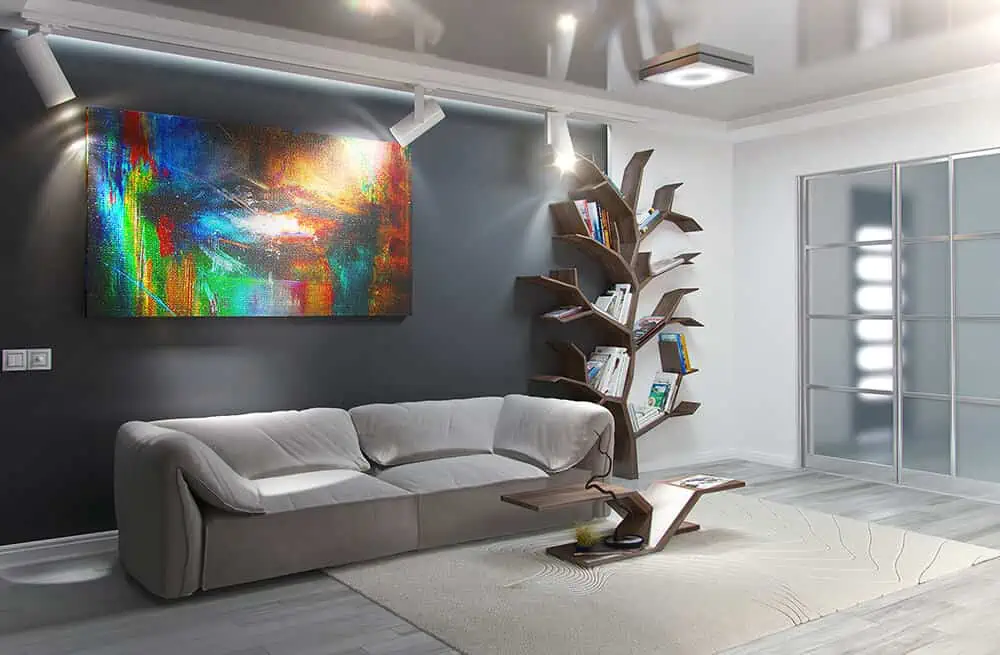
Applications of Different Beam Angles
Since different beam angles produce different light styles, their applications also vary. So let’s take a look at them.
Narrow Beam
A narrow beam angle covers a smaller area but provides more intense light. Such light angles work best for case closets and small kitchens and highlight certain houses’ areas. In commercial spaces, you should prefer it for warehouses and accent lighting tables in restaurants. However, while using these lights in the warehouse, remember that you will get little coverage. Hence, you would need multiple lights to get proper lighting.
Medium
A medium angle strikes a balance between intensity and coverage. Hence, these lights work best in living areas in domestic spaces. However, you can prefer them for ambient lighting in clothing stores in commercial spaces.
Wide
Wide angle has a broader spread and is used to light outdoor spaces. For example, you can use it in a home patio space to provide ambient light to a large commercial store.
Very Wide
Such a beam angle aims to spread the light as far as possible. Hence, these are typically used outdoors in floodlights and street lamps.
How To Select The Right Beam Angle?
Now that you know the impact of beam angle on the lighting conditions, you must also know that several factors determine the right beam angles. You must consider the following factor to select the right beam angle for a particular space. Let’s take a look at them:
Type of Building
The first thing that you should take into account is the type of building. You have to be aware of the space’s size, the ceiling’s height, and the required number of fixtures. If a room has a high ceiling and a shorter area, it would need a lesser number of fixtures. Furthermore, the narrower beam for such spaces would work better because not much spread is required.
In contrast, a building with a wider area and a lower ceiling would be better off with a broader beam angle. Selecting a narrow beam angle for such spaces creates less spread which would not be enough to light up the entire area.
Most buildings have ceiling heights of about 7.9 to 8.9 feet. Lights with a wider angle of 60 degrees will work for such structures. However, if the ceiling is higher than 8.9 feet, you would need multiple lights. And it would help if you chose a narrower beam angle to provide adequate lumens.
Number of Lights
The area of different spaces varies, thus the number of lights required to brighten it up. It is also an essential factor that you should consider when selecting a beam angle. If space requires two or more lights, the beam angle for each one would have to be estimated separately.
You would have to devise a lighting plan and assign a portion of the area to each light source. That particular light source should have a beam angle that covers the entire area and provides adequate lumens.
Not all portions of the space need to have the same area. Hence, the requirement for each part can vary. The point is you cannot select an optimal beam angle based on the calculation of a single portion.
Another critical point is that all the light beams in a single space must overlap. Otherwise, there will be areas that receive no light and will be darker.
Different LED Lights
Once you have noted down the lighting requirements of the space, you would have to pick between several LED types. Each of these types offers a different beam angle which you should consider before purchasing them. The beam angle of a LED might vary within its category, but the following table shows general beam angles of different categories.
| LED Type | Beam Angle |
| LED Downlight | 30-60 |
| LED High Bay light | 60-120 |
| LED Tube Light | 120-160 |
| LED Flood Light | 120-150 |
| LED Corn Light | 180-360 |
| LED Spotlight | 15-90 |
| LED Strip Light | 120 |
| COB LED Strip Light | 180 |
Right Beam Angles For Different Spaces
Now that we have covered the basics of beam lights, let’s move on to the lighting requirements of different spaces. Generally, we can divide light styles into two categories, domestic and commercial. The two types have different applications; hence, the appropriate beam angles also vary. So, let’s take a look at them.
Residential Buildings
Residential buildings have lower ceilings and square areas than commercial properties. Furthermore, the lighting requirements mostly stay the same for the houses and apartments. Hence, you can use the same beam angle in both spaces. For most domestic spaces, the beam angle of 40-60 degrees would work the best. This angle will cover the entire space area, including a bedroom, kitchen, and bathroom.
However, the living rooms generally have a larger area, so it needs more spread than the other spaces in a house. Hence, it would be best if you chose anything above 60 degrees to light up the living room. The calculation might vary based on the factors discussed in the earlier section.
In addition to covering the significant spaces, specific components such as staircases, closets, and kitchen cabinets also have lighting requirements. Because the light in such areas has to cover a narrower region, a narrower angle of about 25 degrees is ideal for them.
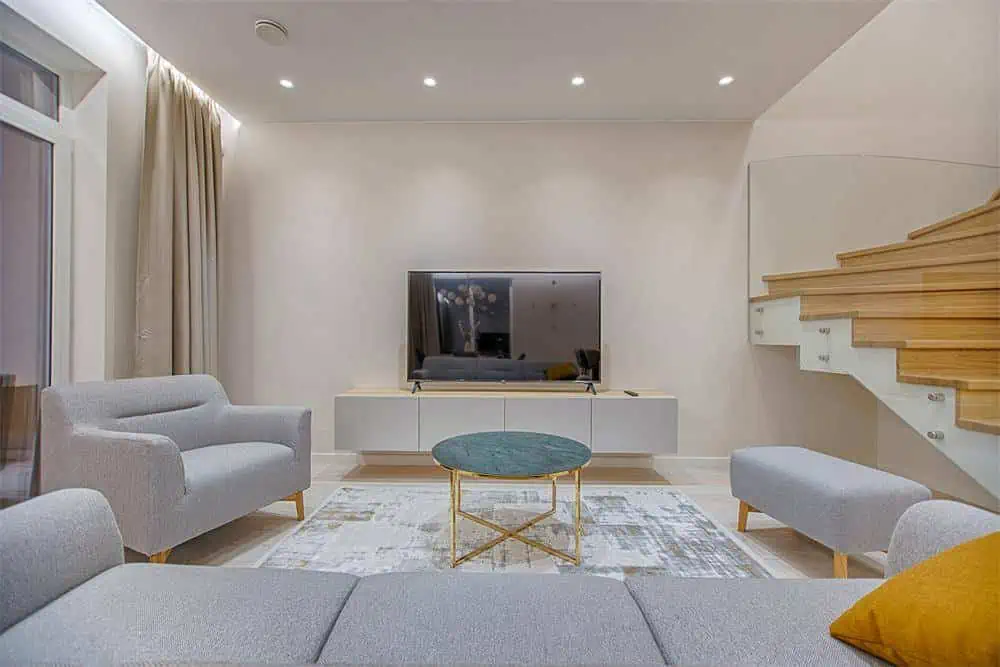
Commercial Buildings
Commercial buildings have several types, and the lighting requirements for each class vary significantly. Hence, we have divided them into the following sub-categories.
Offices
Workspaces like offices need intense lighting in all of their areas to ensure that the space of every employee is well-lit. It is imperative in workplaces where employees spend most of their time on laptops and desktops. Poor lighting conditions around the desk can cause strain on the eyes, which can decrease productivity. Such spaces benefit the best from lights with narrower beam angles to provide more intensity. However, you must install more lights to cover the entire area.
Warehouses
Warehouses typically have higher ceilings than other Commercial spaces. A wider beam angle would not help because light would not reach down because of low intensity. You should use a narrower beam and install multiple lights to brighten a warehouse. However, the wider beam can also be opted for only when you install the lights into walls instead of ceilings.

Retail Stores
The purpose of lighting in retail stores is not just to provide adequate brightness in the space but also to showcase products. Hence, it requires brighter and more intense light, which narrower beams can achieve. You can use a combination of light beams to provide optimal light in the entire store.
For example, the wider beam can be used in ceilings to cover the whole store. In contrast, you can use very narrow beams, such as 10 degrees in racks, to highlight the products.
Restaurants
Most restaurants open up in the evening, and the purpose of lighting in such spaces is to highlight the aesthetics. You should use narrower beam light in these spaces but be mindful that they should be somewhat light. A daylight environment within a restaurant would not work well. Furthermore, very narrow beams, such as 10 to 25, can be used to highlight the restaurant’s decor.
FAQs
The beam angle is the measure of how light spreads from its source. “α” represents the beam angle, and you can calculate it by the formula, which is α = 2. (arctan(Ø/2.d)). The “d” is the distance between the light source and the surface. Ø is the diameter of the light, and arctan represents the inverse function of the tangent in angle calculation.
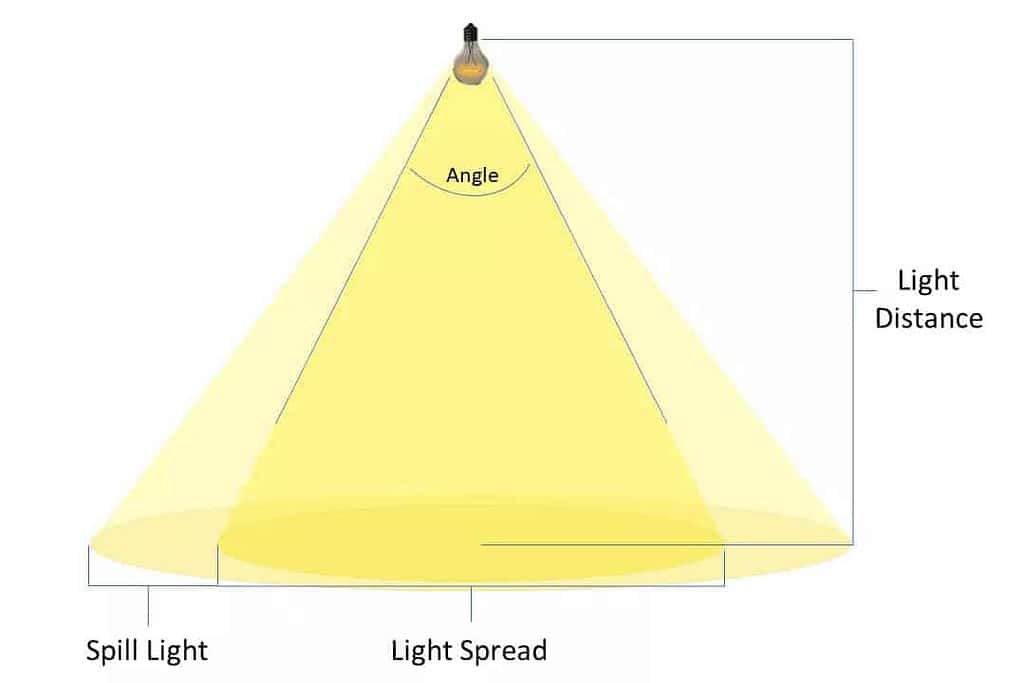
Beam spread describes the spread of light from its source, which plays a vital role in lighting a space. You must understand how different beams spread at different angles to select optimal beam angles for LEDs in homes and offices.
As the name indicates, a parabolic reflector is a reflective surface that you can use to collect and project energies, including light. These reflectors are used in homes and offices when the beam angles of the light are too broad. You can install such reflectors above the light source to project the light that spreads away from the target region. Typically, you use reflectors with lights that have beam angles of more than 120 degrees.
You can use Spotlights to brighten a particular spot while leaving the other areas in the dark. Hence, more intense and focused light is required, which you can achieve with narrower beam angles. Thus, the spotlights have beam angles below 45 degrees. Whereas you use the floodlight to brighten up a larger area, it requires a broader beam angle. Therefore, these lights typically have a beam angle of about 90 degrees or above.
You can calculate the amount of wattage required for a room by calculating the area of the room in square feet. Then, multiply the number by 10 to get the watt needed for a room. For example, if the room has an area of 10×10 sq. feet. The total area would be 100, and multiplying it by ten would result in 1000, which is the watt requirement of that room.
Conclusion – Beam Angle
Beam angle describes the spread of light, one of the most important factors to consider while lighting a space. Selecting a wrong beam angle would result in appropriate lighting, which would be too bright in some spots and too dark in others. And to find suitable beam angles, one has to consider several factors. The most important of them is the area, height of the ceiling, and the purpose of the lighting. You will get optimal lighting conditions if you base the decision on all these factors.
We hope this piece has been helpful. Let us know your queries in the comment section. We would love to respond. Thank you!
We are a factory specializing in producing LEDYi manufactures high-quality LED strips and LED neon flex. All of our products go through high-tech laboratories to ensure the utmost quality. Besides, we offer customizable options on our LED strips and neon flex. So, for premium LED strip and LED neon flex, contact LEDYi ASAP!.

